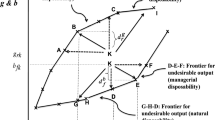Abstract
Recently, environmental protection and regulations such as WEEE, ELV, and RoHS are rapidly emerging as an important issue for business to consider. The trend of swinging from end-of-pipe control to product design, green innovation, and even the establishment of image or brand has affected corporations in almost every corner in the world, and enlarged to the all modern global production network. Corporations must take proactive environmental strategies to response the challenges. This study adopts balanced scorecard structure and aim at automobile industries to understand the relationships of internal and external, financial and non-financial, and outcome and driving factors. Further relying on these relationships to draw the “map of environment strategy” to probe and understand the feasibility of environmental performance evaluation and environmental strategy control.
Similar content being viewed by others
References
Dias-Sardinha, I., Reilnders, L., & Antunes, P. (2002). From environmental performance evaluation to eco-efficiency and sustainability balanced scorecard. Environmental Quality Management, 12(2), 51–64.
Figge, F., Hahn, T., Schaltegger, S., & Wagner, M. (2002). The sustainability balanced scorecard—linking sustainability management to business strategy. Business Strategy and the Environment, 11(5), 269–284.
Johnson, S. D. (1998). Application of the balanced scorecard approach. Corporate Environmental Strategy, 5, 34–41.
Kaplan, R. S., & Norton, D. P. (1996). The balanced scorecard. Boston: Harvard Business School Press.
Kaplan, R. S., & Norton, D. P. (2004). Strategy maps. Boston: Harvard Business School Press.
King, A. A., & Lenox, M. J. (2001). Lean and green? An empirical examination of the relationship between lean production and environmental performance. Production and Operations Management, 10(3), 244–256.
Klassen, R. D., McLaughlin, & Curtis, P. (1996). The impact of environmental management on firm performance. Management Science, 42(8), 1199–1214.
Koner, S., & Cohen, M. A. (2001). Does the market value environmental performance? The Review of Economics and Statistics, 83(2), 281.
Porter, M. (1995). Green competitiveness. Harvard Business Review, September.
Author information
Authors and Affiliations
Corresponding author
Rights and permissions
About this article
Cite this article
Hsu, YL., Liu, CC. Environmental performance evaluation and strategy management using balanced scorecard. Environ Monit Assess 170, 599–607 (2010). https://doi.org/10.1007/s10661-009-1260-7
Received:
Accepted:
Published:
Issue Date:
DOI: https://doi.org/10.1007/s10661-009-1260-7




